Each year at SuiteWorld we field a team for Hackathon 4Good – a chance to solve a real brief from a not for profit. Last year we took the win. This year we were pipped at the post, but we did build a repeatable solution for forecasting volatility, balancing warehouses and actioning stock moves in NetSuite – one that many Annexa customers could benefit from.
Our hackathon entry was a lightweight solution concept designed to learn from historical data, forecast demand by site and deliver clear transfer recommendations in NetSuite. It demonstrated how spikes and shortfalls could be flagged early, guiding planners to shift stock from oversupplied to undersupplied locations. In scenario tests aligned to the Soles4Souls brief, this approach showed potential to unlock 8–10% more value across the network – around US$42 million* in a representative year.
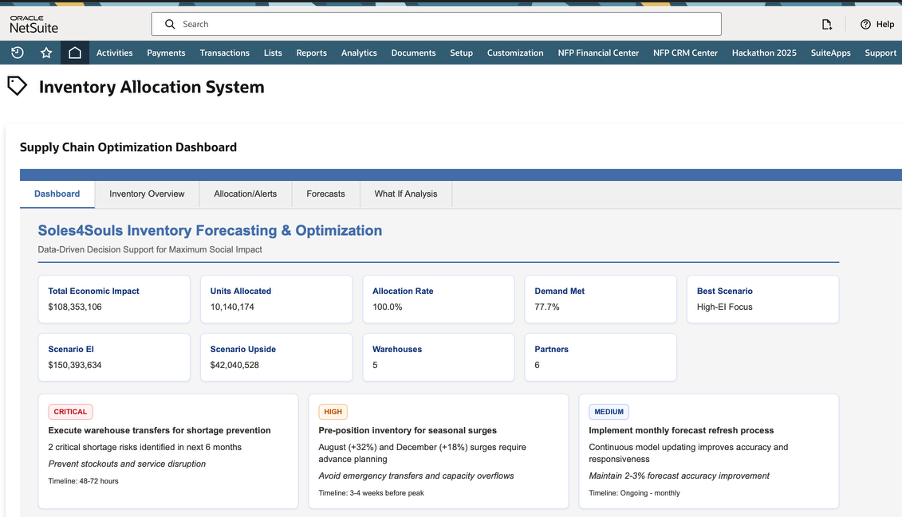
Hackathon 4Good prototype dashboard – forecasting, alerts and scenario planning surfaced directly in NetSuite for Soles4Souls.
While the prototype was built for not-for-profits, the architecture makes it a strong fit for any organisation that needs smarter inventory planning without the overhead of a full supply-chain suite. It covers the essentials – demand forecasting, allocation and transfer logic – but with the advantage of running inside NetSuite. That means faster setup, lower cost and a practical path for growing businesses that want more than spreadsheets but can’t justify a six-figure external system.
This makes it a natural fit for growing businesses that want to move beyond spreadsheets and manual rules but don’t want to commit to a six-figure external system.
For those who want to know more about the inner workings, below we take a technical deep dive into the details of our SuiteWorld Hackathon 4Good entry.
About Soles4Souls and the Hackathon 4Good brief
NetSuite customer, Soles4Souls, is a US-based not for profit that creates opportunity through shoes and clothing, combining disaster relief, micro-enterprise and school programmes to put donated items to work at scale. Since 2006 they’ve moved well over over 50 million items of footwear and apparel across 129 countries.
Naturally, they want to maximise the impact of every donation. Day to day they balance hundreds of thousands of items across multiple warehouses, direct stock to where it creates the most value and plan for known peaks and likely disruptions. In practice this means distributing to partners so stock is used and never wasted, shipping from the most suitable warehouse to reduce freight cost and time and keeping locations in balance so new donations aren’t turned away.
For Hackathon 4Good they asked teams to build a forecasting model that accounts for:
- Forecast donations and distributions with seasonality and shocks
- Keep warehouses balanced to avoid overflow or stockouts
- Ship from the optimal site to reduce freight cost and lead time
- Prioritise partners and programmes with highest impact
- Plan ahead for back-to-school, holiday peaks and disaster response
Please note that all data used and shown in this article was synthetic, based on the Soles4Souls brief.
Building the NetSuite inventory forecasting solution
The solution mechanics
Behind the scenes, NetSuite connected to Oracle Cloud Infrastructure’s machine learning engine to pull data, run the models and feed forecasts back into NetSuite dimensions – by product, warehouse, customer or programme. Multiple models were tested and tuned, with outputs simplified for decision-makers: a reliable forecast and a clear set of transfer recommendations.
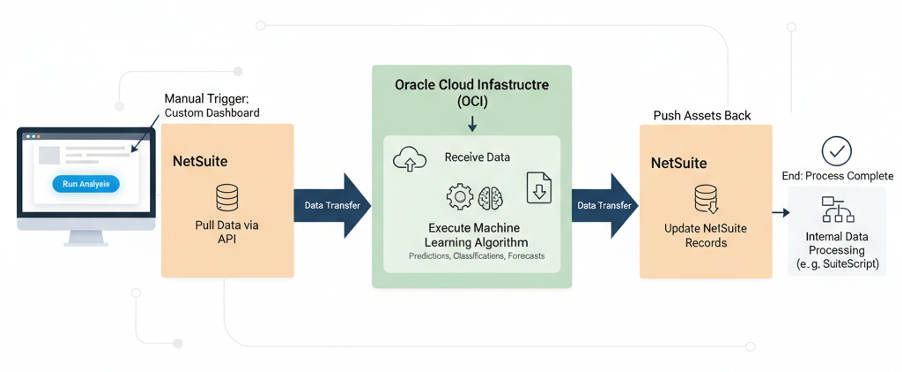
NetSuite data is pulled into Oracle Cloud Infrastructure, where machine learning models run predictions, classifications and forecasts. The results are then pushed back into NetSuite, updating records and triggering automated processes.
The models powering the solution
The forecasting engine combined several well-established machine learning models, each chosen for its strengths:
- Prophet model – handled seasonality and incorporated business drivers like product mix and peak sales periods
- Net flow method – forecasted the difference between inflows and outflows to reduce compounding errors
- XGBoost model – used advanced feature engineering to capture complex, non-linear demand patterns
- Weighted ensemble – blended all models into a final forecast, with each weighted by accuracy on a validation set
This ensemble approach produced forecasts that were both reliable and explainable for planners.
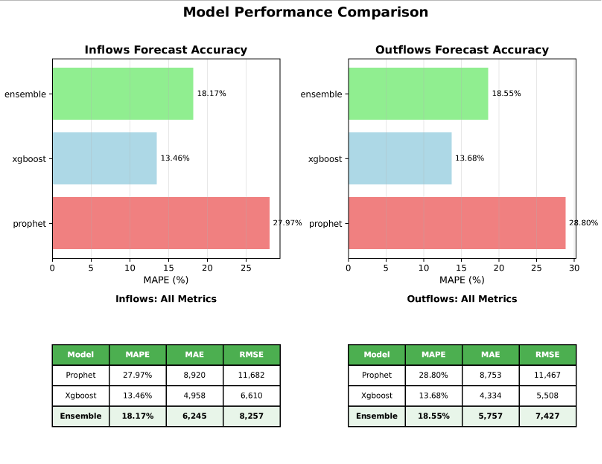
Model comparison showing how different forecasting approaches performed. XGBoost captured complex non-linear patterns most accurately, while Prophet handled broad seasonal trends.
Cleaning up bad data and outliers
Reliable forecasts require clean data so we included multiple safeguards to remove noise and ensure the models could be trusted:
- Outlier filtering – extreme values were removed using statistical thresholds, preventing unusual spikes from skewing results
- Anomaly handling – COVID-era disruptions (2020–2021) were excluded, with controls to adjust the scope if needed
- Validation checks – forecasts were backtested against 2023, then blind-tested on 2024 to confirm accuracy
- Capacity cross-checks – warehouse capacity was inferred using three independent methods, then averaged with a 15% buffer to avoid overconfidence
- Missing data treatment – short gaps were forward-filled, medium gaps interpolated and separate models applied to handle sparse or intermittent series
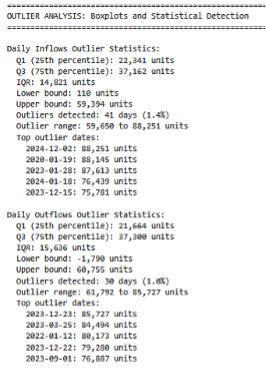
Outlier detection flagged unusual spikes in daily inflows and outflows. By applying the interquartile range (IQR) method, extreme values were isolated so they wouldn’t distort forecasts.
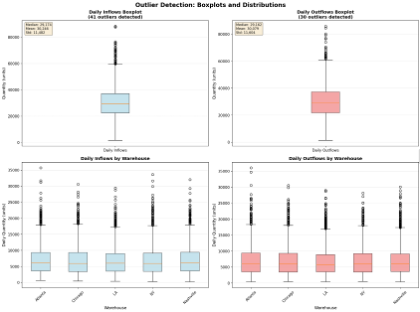
Boxplots revealed outlier behaviour across individual warehouses. This helped validate where anomalies were genuine operational events versus data quality issues.
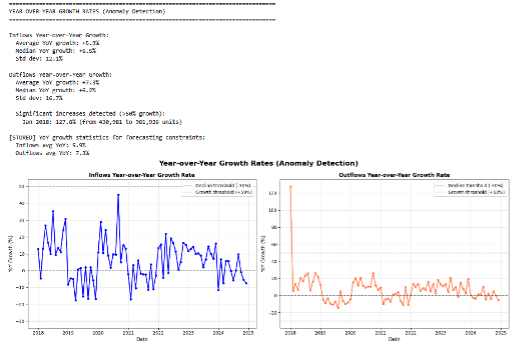
Year-over-year growth rates highlighted structural anomalies such as extreme surges in early 2018. COVID-period data (2020–2021) was excluded to avoid skewing long-term capacity forecasts.
Fine tuning the forecast
Getting accuracy to a production-ready level required the team to engineer features to help the system distinguish between normal trends and genuine anomalies. Spikes were explicitly flagged, giving the model signals it could learn from instead of being thrown off. This reduced forecast error (MAPE) from around 30% to 20% – a significant gain in real-world planning terms.
Under the hood, extra features captured seasonal cycles, lagged effects and rolling averages, while smoothing out noise. This helped the model recognise both predictable patterns like back-to-school surges and sudden shifts like disaster response. The result was a forecast that planners could trust – reliable enough to guide decisions on where to hold stock and when to move it.
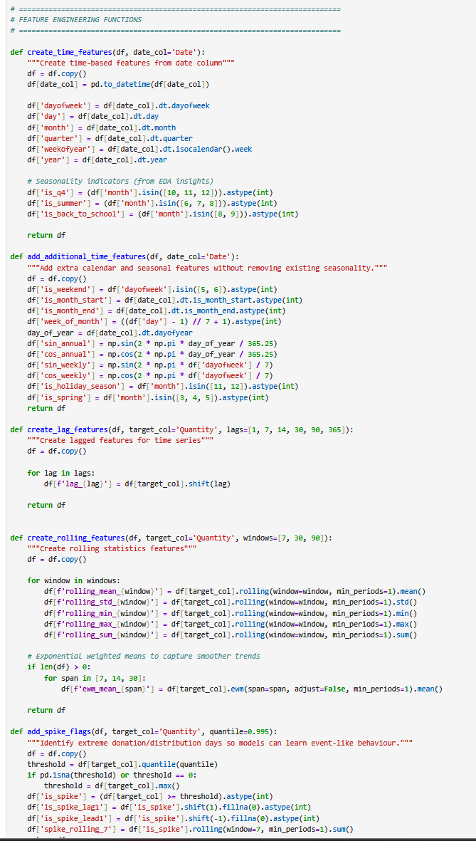
Fine-tuning added anomaly signals that cut forecast error from 30% to 20%.
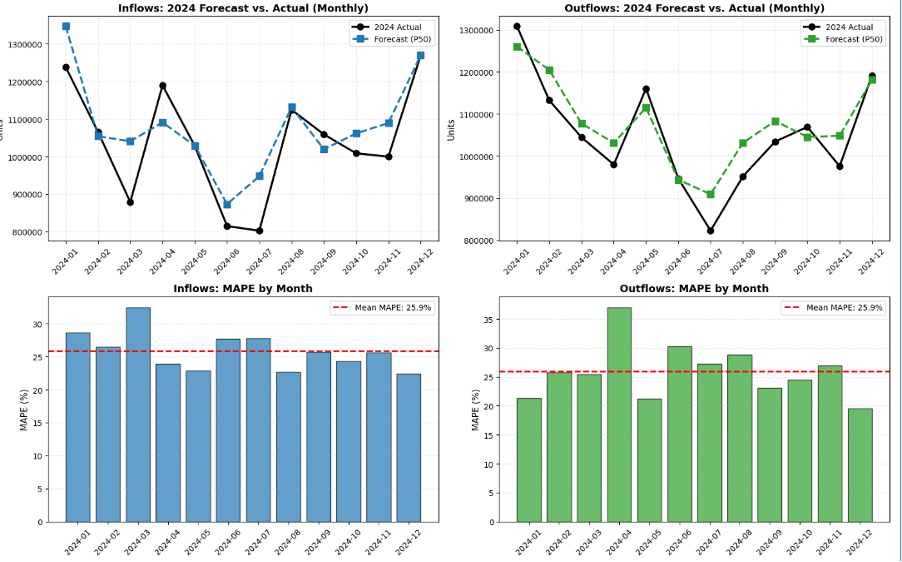
Forecast accuracy validated on 2024 data, showing the model closely tracked real inflows and outflows across the year. Monthly error rates (MAPE) averaged around 25%, with predictable peaks and troughs like post-holiday slowdowns and back-to-school surges correctly flagged in advance.
Optimising for economic impact
At the core of the solution was an optimisation model built in PuLP, designed to maximise the economic impact of Soles4Souls’ donation network. Rather than treating allocation as a single snapshot, the model ran on a 12-month horizon, allowing it to anticipate seasonal surges and plan ahead for shortages.
Several safeguards shaped the way the model worked. Capacity constraints ensured no warehouse was ever overfilled. Demand fulfilment logic prioritised partners and programmes to make sure stock moved where it created the most value. Cost minimisation rules reduced unnecessary transfers to cut freight overhead. And above all, the model’s primary objective was to maximise economic impact — every donation needed to go to the place it would generate the highest return.
This thinking surfaced in the prototype dashboard, where planners could see headline figures like total economic impact, allocation rates, scenario upside and partner demand met. Alongside those numbers were practical alerts – warnings about projected shortages, guidance to pre-position inventory before seasonal peaks and reminders to refresh models monthly for ongoing accuracy.
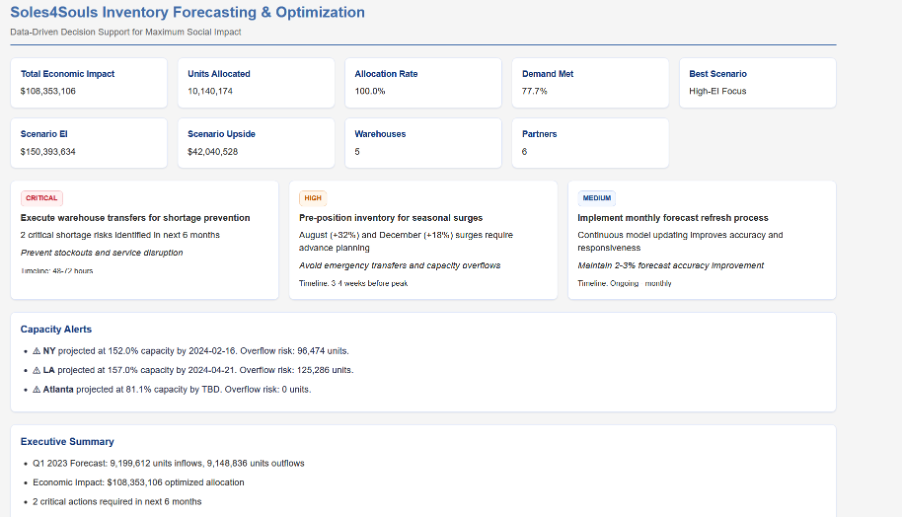
Optimisation model in action: PuLP ran a 12-month forecast with constraints and objectives to maximise Soles4Souls’ economic impact, producing clear metrics and actionable alerts in a NetSuite dashboard.
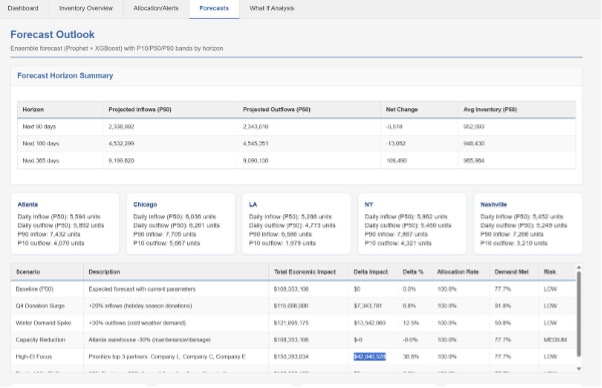
Scenario planning in action – the model highlights where strategic shifts unlock upside. In this case, focusing on high-impact programmes delivered a projected US$42M* (+38.8%) gain, with additional value identified in Q4 donation surges and winter demand spikes.
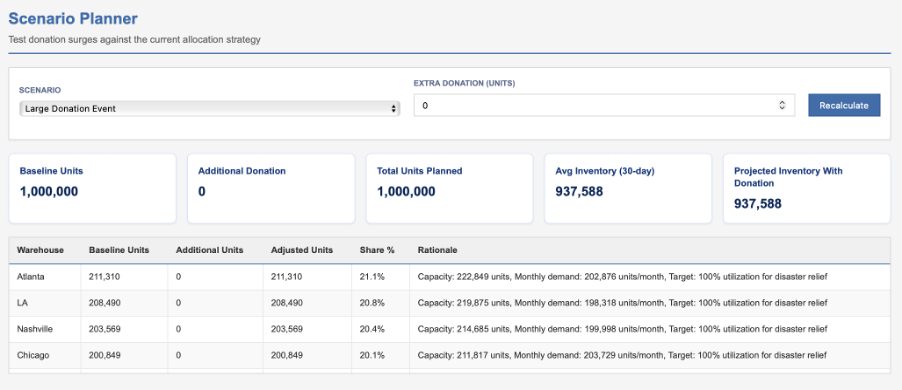
What happens when a major donation arrives? The scenario planner instantly shows how units should be redistributed across warehouses to stay balanced and effective.
Precision was our solution differentiator
There is little doubt that all teams presented strong concepts at Hackathon 4Good, but we believe our differentiator was accuracy. By validating the model against an unseen year of data, we could demonstrate forecasts that closely matched reality. That accuracy matters because reliable forecasts drive reliable decisions.
A big part of that accuracy came from the way the model treated data. Outliers were filtered, trends and seasonality were captured and more than 120 parameters were tuned to refine the fit. The result was a model that could be trusted to both report history and predict the future with greater accuracy.
The value delivered for Soles4Souls
For Soles4Souls, the model showed what better planning can achieve. It allowed warehouse balancing, supported donor and partner engagement and helped fulfil more programmes. In scenario tests, the approach unlocked roughly 8–10% more value across the network – equivalent to about US$42 million* on a representative year.
Most importantly, the forecasts held up when tested. Training on 2017-2023 data and forecasting 2024 produced results within a few percent of actual inflows and outflows – 9.2 million forecast versus 9.1 million actual.
A NetSuite inventory forecasting solution fit for more NetSuite customers
This approach isn’t unique to not for profits. In fact, it’s how modern inventory planning systems work – learn from history, forecast forward and optimise stock across sites. The difference is that this was built as a lightweight, NetSuite-connected solution rather than a heavy, third-party system. That makes it more cost-effective and customisable for organisations that can’t justify the expense of a full enterprise application.
Please reach out to learn more.
* Potential savings based on based on the synthetic data provided as part of the Hackathon competition